Business Finance Report: Budgeting Methods and Analysis
VerifiedAdded on 2020/07/23
|9
|3043
|36
Report
AI Summary
This report delves into the intricacies of business finance, specifically focusing on the budgeting process and its significance within an organization. It begins by outlining the purpose of budgeting, emphasizing its role in planning, cost management, and decision-making, particularly within the context of TownScape Plc, an international manufacturer. The report then explores the traditional budgeting approach, evaluating its application in planning, costing, and cost management. It also examines the effectiveness of this approach, considering both its advantages and disadvantages. Furthermore, the report introduces alternative budgeting methods, such as zero-based and activity-based budgeting, analyzing their potential applications and benefits. The analysis includes a comparative evaluation of different methods to enhance organizational effectiveness, providing a comprehensive understanding of budgeting techniques in business finance.

BUSINESS FINANCE
1
1
Paraphrase This Document
Need a fresh take? Get an instant paraphrase of this document with our AI Paraphraser
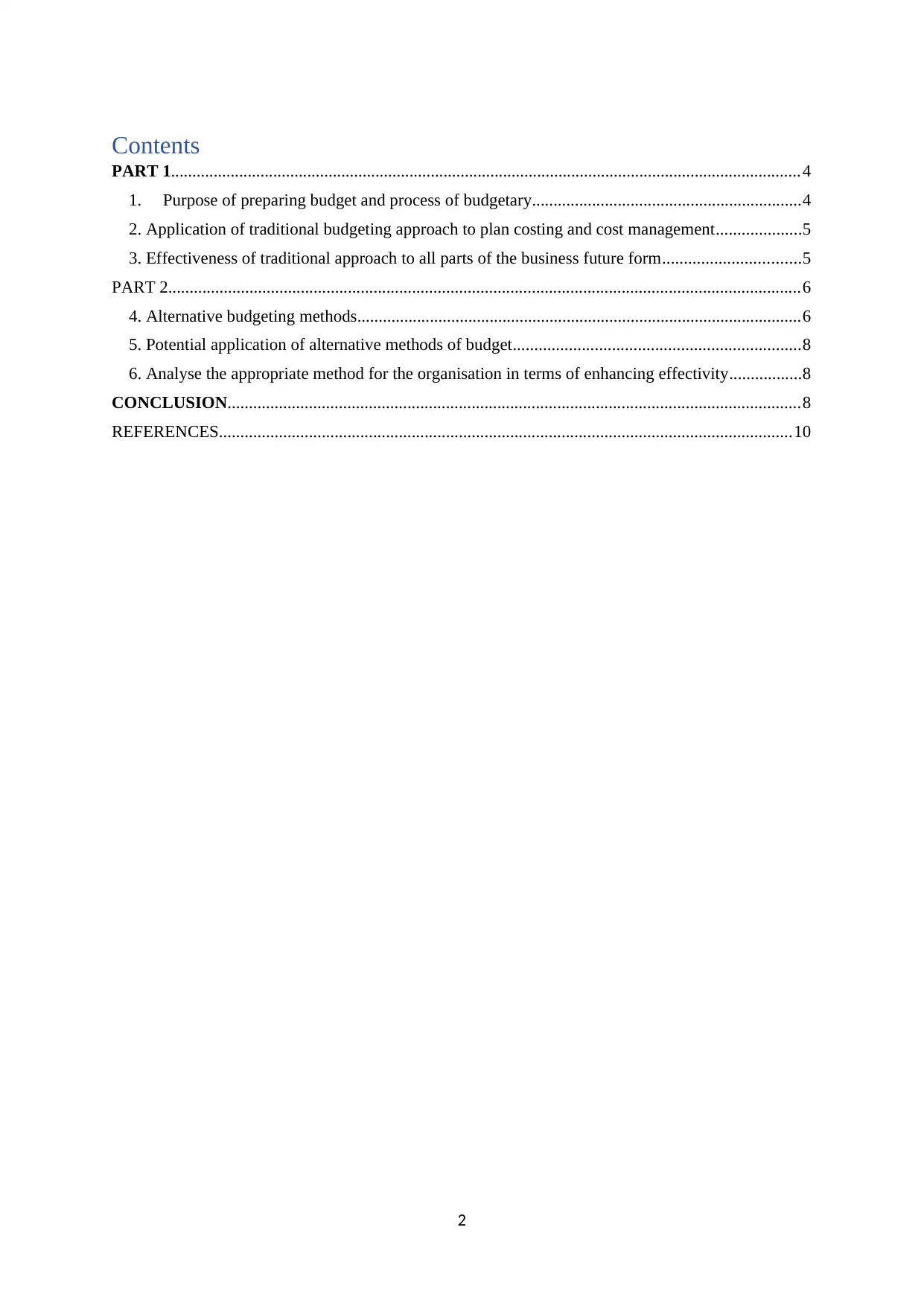
Contents
PART 1....................................................................................................................................................4
1. Purpose of preparing budget and process of budgetary...............................................................4
2. Application of traditional budgeting approach to plan costing and cost management....................5
3. Effectiveness of traditional approach to all parts of the business future form................................5
PART 2....................................................................................................................................................6
4. Alternative budgeting methods........................................................................................................6
5. Potential application of alternative methods of budget...................................................................8
6. Analyse the appropriate method for the organisation in terms of enhancing effectivity.................8
CONCLUSION......................................................................................................................................8
REFERENCES......................................................................................................................................10
2
PART 1....................................................................................................................................................4
1. Purpose of preparing budget and process of budgetary...............................................................4
2. Application of traditional budgeting approach to plan costing and cost management....................5
3. Effectiveness of traditional approach to all parts of the business future form................................5
PART 2....................................................................................................................................................6
4. Alternative budgeting methods........................................................................................................6
5. Potential application of alternative methods of budget...................................................................8
6. Analyse the appropriate method for the organisation in terms of enhancing effectivity.................8
CONCLUSION......................................................................................................................................8
REFERENCES......................................................................................................................................10
2
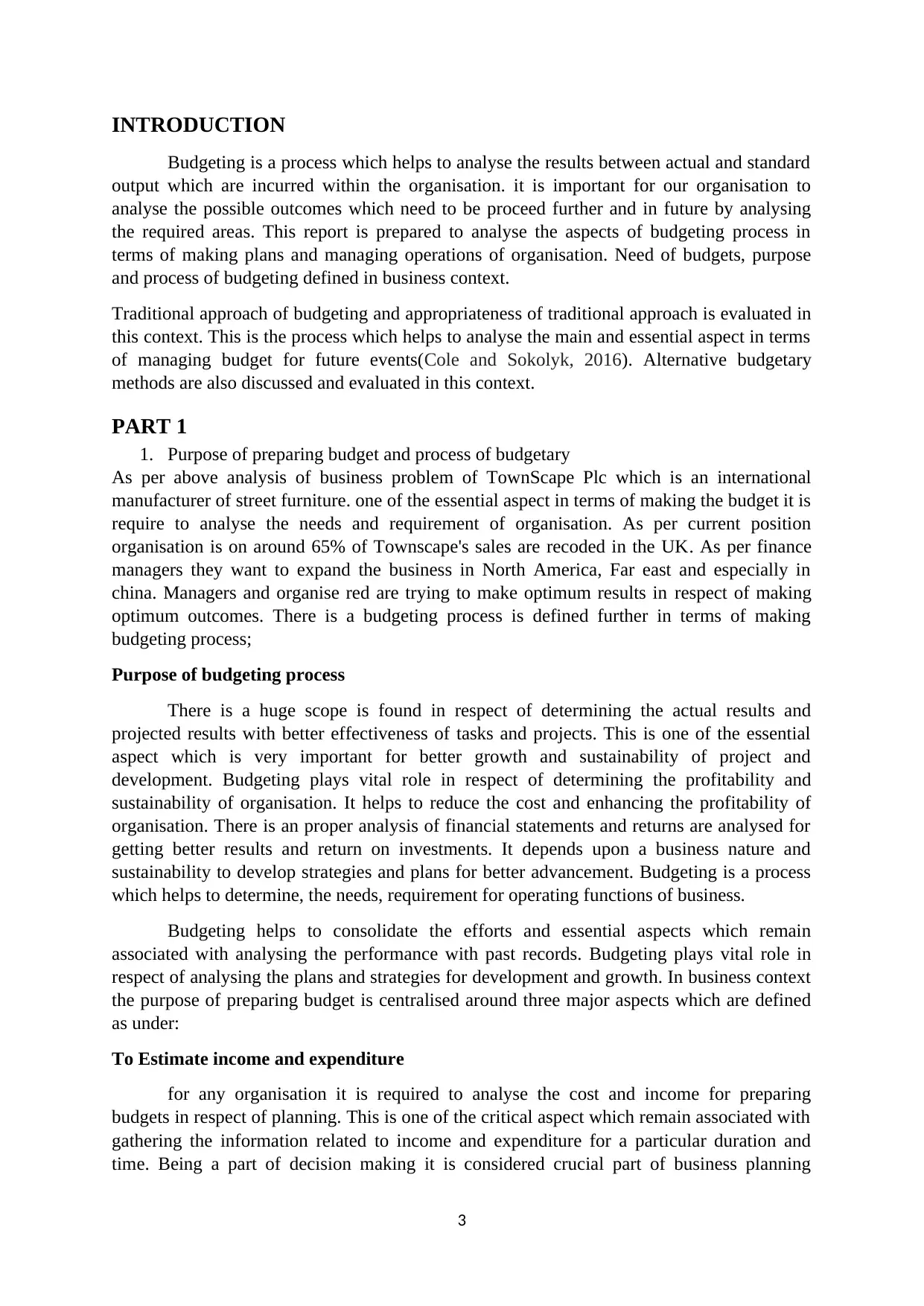
INTRODUCTION
Budgeting is a process which helps to analyse the results between actual and standard
output which are incurred within the organisation. it is important for our organisation to
analyse the possible outcomes which need to be proceed further and in future by analysing
the required areas. This report is prepared to analyse the aspects of budgeting process in
terms of making plans and managing operations of organisation. Need of budgets, purpose
and process of budgeting defined in business context.
Traditional approach of budgeting and appropriateness of traditional approach is evaluated in
this context. This is the process which helps to analyse the main and essential aspect in terms
of managing budget for future events(Cole and Sokolyk, 2016). Alternative budgetary
methods are also discussed and evaluated in this context.
PART 1
1. Purpose of preparing budget and process of budgetary
As per above analysis of business problem of TownScape Plc which is an international
manufacturer of street furniture. one of the essential aspect in terms of making the budget it is
require to analyse the needs and requirement of organisation. As per current position
organisation is on around 65% of Townscape's sales are recoded in the UK. As per finance
managers they want to expand the business in North America, Far east and especially in
china. Managers and organise red are trying to make optimum results in respect of making
optimum outcomes. There is a budgeting process is defined further in terms of making
budgeting process;
Purpose of budgeting process
There is a huge scope is found in respect of determining the actual results and
projected results with better effectiveness of tasks and projects. This is one of the essential
aspect which is very important for better growth and sustainability of project and
development. Budgeting plays vital role in respect of determining the profitability and
sustainability of organisation. It helps to reduce the cost and enhancing the profitability of
organisation. There is an proper analysis of financial statements and returns are analysed for
getting better results and return on investments. It depends upon a business nature and
sustainability to develop strategies and plans for better advancement. Budgeting is a process
which helps to determine, the needs, requirement for operating functions of business.
Budgeting helps to consolidate the efforts and essential aspects which remain
associated with analysing the performance with past records. Budgeting plays vital role in
respect of analysing the plans and strategies for development and growth. In business context
the purpose of preparing budget is centralised around three major aspects which are defined
as under:
To Estimate income and expenditure
for any organisation it is required to analyse the cost and income for preparing
budgets in respect of planning. This is one of the critical aspect which remain associated with
gathering the information related to income and expenditure for a particular duration and
time. Being a part of decision making it is considered crucial part of business planning
3
Budgeting is a process which helps to analyse the results between actual and standard
output which are incurred within the organisation. it is important for our organisation to
analyse the possible outcomes which need to be proceed further and in future by analysing
the required areas. This report is prepared to analyse the aspects of budgeting process in
terms of making plans and managing operations of organisation. Need of budgets, purpose
and process of budgeting defined in business context.
Traditional approach of budgeting and appropriateness of traditional approach is evaluated in
this context. This is the process which helps to analyse the main and essential aspect in terms
of managing budget for future events(Cole and Sokolyk, 2016). Alternative budgetary
methods are also discussed and evaluated in this context.
PART 1
1. Purpose of preparing budget and process of budgetary
As per above analysis of business problem of TownScape Plc which is an international
manufacturer of street furniture. one of the essential aspect in terms of making the budget it is
require to analyse the needs and requirement of organisation. As per current position
organisation is on around 65% of Townscape's sales are recoded in the UK. As per finance
managers they want to expand the business in North America, Far east and especially in
china. Managers and organise red are trying to make optimum results in respect of making
optimum outcomes. There is a budgeting process is defined further in terms of making
budgeting process;
Purpose of budgeting process
There is a huge scope is found in respect of determining the actual results and
projected results with better effectiveness of tasks and projects. This is one of the essential
aspect which is very important for better growth and sustainability of project and
development. Budgeting plays vital role in respect of determining the profitability and
sustainability of organisation. It helps to reduce the cost and enhancing the profitability of
organisation. There is an proper analysis of financial statements and returns are analysed for
getting better results and return on investments. It depends upon a business nature and
sustainability to develop strategies and plans for better advancement. Budgeting is a process
which helps to determine, the needs, requirement for operating functions of business.
Budgeting helps to consolidate the efforts and essential aspects which remain
associated with analysing the performance with past records. Budgeting plays vital role in
respect of analysing the plans and strategies for development and growth. In business context
the purpose of preparing budget is centralised around three major aspects which are defined
as under:
To Estimate income and expenditure
for any organisation it is required to analyse the cost and income for preparing
budgets in respect of planning. This is one of the critical aspect which remain associated with
gathering the information related to income and expenditure for a particular duration and
time. Being a part of decision making it is considered crucial part of business planning
3
⊘ This is a preview!⊘
Do you want full access?
Subscribe today to unlock all pages.

Trusted by 1+ million students worldwide
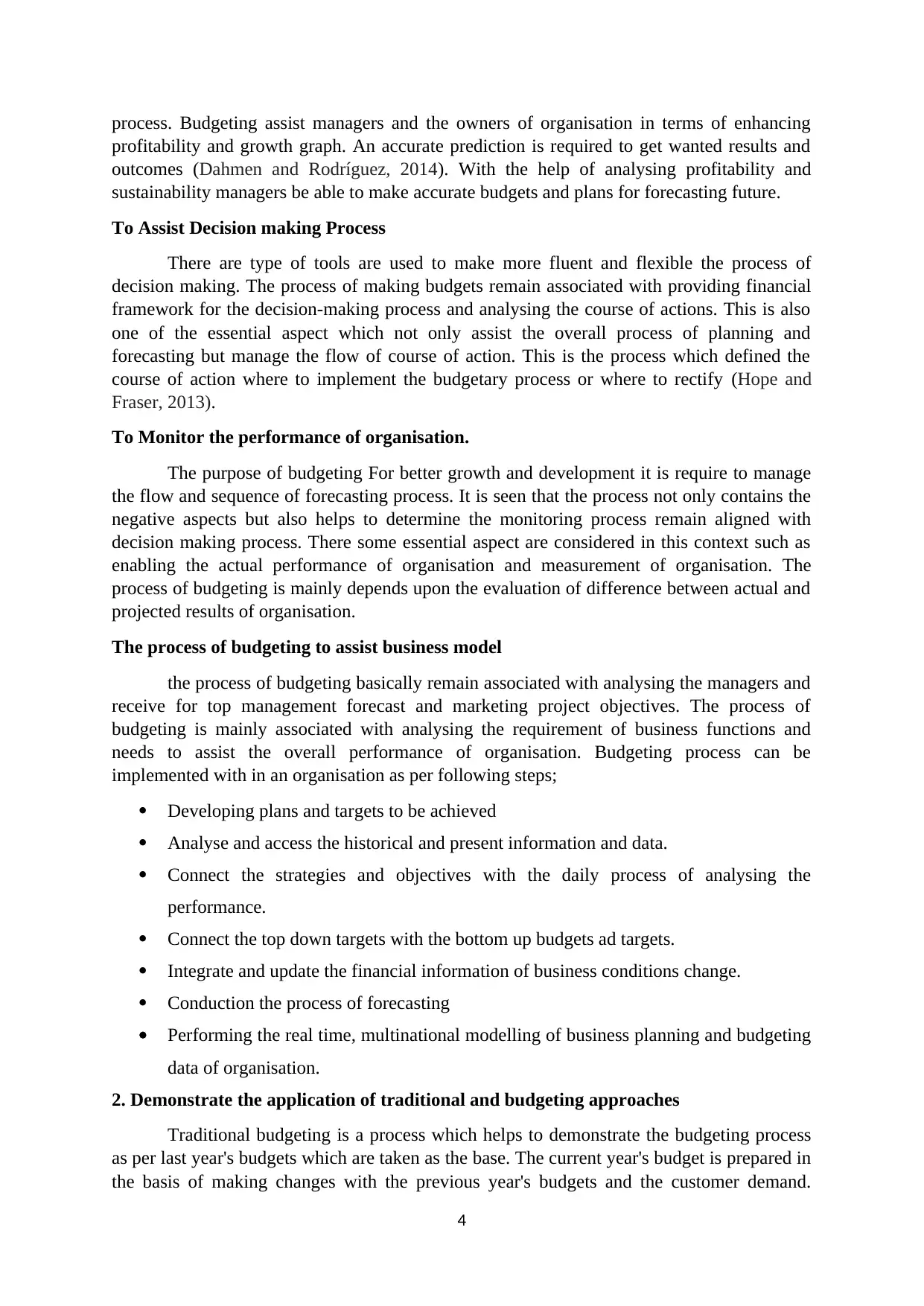
process. Budgeting assist managers and the owners of organisation in terms of enhancing
profitability and growth graph. An accurate prediction is required to get wanted results and
outcomes (Dahmen and Rodríguez, 2014). With the help of analysing profitability and
sustainability managers be able to make accurate budgets and plans for forecasting future.
To Assist Decision making Process
There are type of tools are used to make more fluent and flexible the process of
decision making. The process of making budgets remain associated with providing financial
framework for the decision-making process and analysing the course of actions. This is also
one of the essential aspect which not only assist the overall process of planning and
forecasting but manage the flow of course of action. This is the process which defined the
course of action where to implement the budgetary process or where to rectify (Hope and
Fraser, 2013).
To Monitor the performance of organisation.
The purpose of budgeting For better growth and development it is require to manage
the flow and sequence of forecasting process. It is seen that the process not only contains the
negative aspects but also helps to determine the monitoring process remain aligned with
decision making process. There some essential aspect are considered in this context such as
enabling the actual performance of organisation and measurement of organisation. The
process of budgeting is mainly depends upon the evaluation of difference between actual and
projected results of organisation.
The process of budgeting to assist business model
the process of budgeting basically remain associated with analysing the managers and
receive for top management forecast and marketing project objectives. The process of
budgeting is mainly associated with analysing the requirement of business functions and
needs to assist the overall performance of organisation. Budgeting process can be
implemented with in an organisation as per following steps;
Developing plans and targets to be achieved
Analyse and access the historical and present information and data.
Connect the strategies and objectives with the daily process of analysing the
performance.
Connect the top down targets with the bottom up budgets ad targets.
Integrate and update the financial information of business conditions change.
Conduction the process of forecasting
Performing the real time, multinational modelling of business planning and budgeting
data of organisation.
2. Demonstrate the application of traditional and budgeting approaches
Traditional budgeting is a process which helps to demonstrate the budgeting process
as per last year's budgets which are taken as the base. The current year's budget is prepared in
the basis of making changes with the previous year's budgets and the customer demand.
4
profitability and growth graph. An accurate prediction is required to get wanted results and
outcomes (Dahmen and Rodríguez, 2014). With the help of analysing profitability and
sustainability managers be able to make accurate budgets and plans for forecasting future.
To Assist Decision making Process
There are type of tools are used to make more fluent and flexible the process of
decision making. The process of making budgets remain associated with providing financial
framework for the decision-making process and analysing the course of actions. This is also
one of the essential aspect which not only assist the overall process of planning and
forecasting but manage the flow of course of action. This is the process which defined the
course of action where to implement the budgetary process or where to rectify (Hope and
Fraser, 2013).
To Monitor the performance of organisation.
The purpose of budgeting For better growth and development it is require to manage
the flow and sequence of forecasting process. It is seen that the process not only contains the
negative aspects but also helps to determine the monitoring process remain aligned with
decision making process. There some essential aspect are considered in this context such as
enabling the actual performance of organisation and measurement of organisation. The
process of budgeting is mainly depends upon the evaluation of difference between actual and
projected results of organisation.
The process of budgeting to assist business model
the process of budgeting basically remain associated with analysing the managers and
receive for top management forecast and marketing project objectives. The process of
budgeting is mainly associated with analysing the requirement of business functions and
needs to assist the overall performance of organisation. Budgeting process can be
implemented with in an organisation as per following steps;
Developing plans and targets to be achieved
Analyse and access the historical and present information and data.
Connect the strategies and objectives with the daily process of analysing the
performance.
Connect the top down targets with the bottom up budgets ad targets.
Integrate and update the financial information of business conditions change.
Conduction the process of forecasting
Performing the real time, multinational modelling of business planning and budgeting
data of organisation.
2. Demonstrate the application of traditional and budgeting approaches
Traditional budgeting is a process which helps to demonstrate the budgeting process
as per last year's budgets which are taken as the base. The current year's budget is prepared in
the basis of making changes with the previous year's budgets and the customer demand.
4
Paraphrase This Document
Need a fresh take? Get an instant paraphrase of this document with our AI Paraphraser
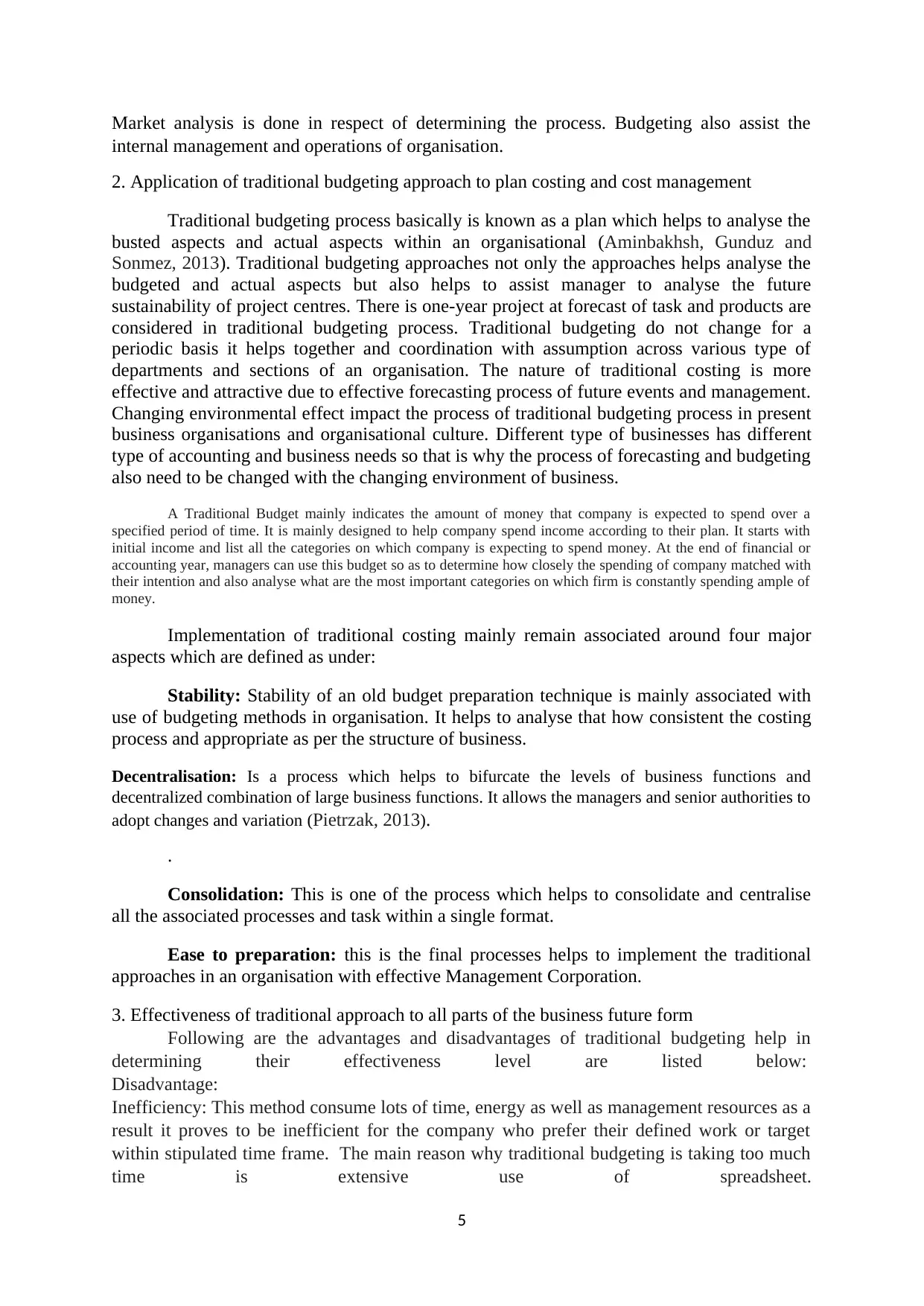
Market analysis is done in respect of determining the process. Budgeting also assist the
internal management and operations of organisation.
2. Application of traditional budgeting approach to plan costing and cost management
Traditional budgeting process basically is known as a plan which helps to analyse the
busted aspects and actual aspects within an organisational (Aminbakhsh, Gunduz and
Sonmez, 2013). Traditional budgeting approaches not only the approaches helps analyse the
budgeted and actual aspects but also helps to assist manager to analyse the future
sustainability of project centres. There is one-year project at forecast of task and products are
considered in traditional budgeting process. Traditional budgeting do not change for a
periodic basis it helps together and coordination with assumption across various type of
departments and sections of an organisation. The nature of traditional costing is more
effective and attractive due to effective forecasting process of future events and management.
Changing environmental effect impact the process of traditional budgeting process in present
business organisations and organisational culture. Different type of businesses has different
type of accounting and business needs so that is why the process of forecasting and budgeting
also need to be changed with the changing environment of business.
A Traditional Budget mainly indicates the amount of money that company is expected to spend over a
specified period of time. It is mainly designed to help company spend income according to their plan. It starts with
initial income and list all the categories on which company is expecting to spend money. At the end of financial or
accounting year, managers can use this budget so as to determine how closely the spending of company matched with
their intention and also analyse what are the most important categories on which firm is constantly spending ample of
money.
Implementation of traditional costing mainly remain associated around four major
aspects which are defined as under:
Stability: Stability of an old budget preparation technique is mainly associated with
use of budgeting methods in organisation. It helps to analyse that how consistent the costing
process and appropriate as per the structure of business.
Decentralisation: Is a process which helps to bifurcate the levels of business functions and
decentralized combination of large business functions. It allows the managers and senior authorities to
adopt changes and variation (Pietrzak, 2013).
.
Consolidation: This is one of the process which helps to consolidate and centralise
all the associated processes and task within a single format.
Ease to preparation: this is the final processes helps to implement the traditional
approaches in an organisation with effective Management Corporation.
3. Effectiveness of traditional approach to all parts of the business future form
Following are the advantages and disadvantages of traditional budgeting help in
determining their effectiveness level are listed below:
Disadvantage:
Inefficiency: This method consume lots of time, energy as well as management resources as a
result it proves to be inefficient for the company who prefer their defined work or target
within stipulated time frame. The main reason why traditional budgeting is taking too much
time is extensive use of spreadsheet.
5
internal management and operations of organisation.
2. Application of traditional budgeting approach to plan costing and cost management
Traditional budgeting process basically is known as a plan which helps to analyse the
busted aspects and actual aspects within an organisational (Aminbakhsh, Gunduz and
Sonmez, 2013). Traditional budgeting approaches not only the approaches helps analyse the
budgeted and actual aspects but also helps to assist manager to analyse the future
sustainability of project centres. There is one-year project at forecast of task and products are
considered in traditional budgeting process. Traditional budgeting do not change for a
periodic basis it helps together and coordination with assumption across various type of
departments and sections of an organisation. The nature of traditional costing is more
effective and attractive due to effective forecasting process of future events and management.
Changing environmental effect impact the process of traditional budgeting process in present
business organisations and organisational culture. Different type of businesses has different
type of accounting and business needs so that is why the process of forecasting and budgeting
also need to be changed with the changing environment of business.
A Traditional Budget mainly indicates the amount of money that company is expected to spend over a
specified period of time. It is mainly designed to help company spend income according to their plan. It starts with
initial income and list all the categories on which company is expecting to spend money. At the end of financial or
accounting year, managers can use this budget so as to determine how closely the spending of company matched with
their intention and also analyse what are the most important categories on which firm is constantly spending ample of
money.
Implementation of traditional costing mainly remain associated around four major
aspects which are defined as under:
Stability: Stability of an old budget preparation technique is mainly associated with
use of budgeting methods in organisation. It helps to analyse that how consistent the costing
process and appropriate as per the structure of business.
Decentralisation: Is a process which helps to bifurcate the levels of business functions and
decentralized combination of large business functions. It allows the managers and senior authorities to
adopt changes and variation (Pietrzak, 2013).
.
Consolidation: This is one of the process which helps to consolidate and centralise
all the associated processes and task within a single format.
Ease to preparation: this is the final processes helps to implement the traditional
approaches in an organisation with effective Management Corporation.
3. Effectiveness of traditional approach to all parts of the business future form
Following are the advantages and disadvantages of traditional budgeting help in
determining their effectiveness level are listed below:
Disadvantage:
Inefficiency: This method consume lots of time, energy as well as management resources as a
result it proves to be inefficient for the company who prefer their defined work or target
within stipulated time frame. The main reason why traditional budgeting is taking too much
time is extensive use of spreadsheet.
5
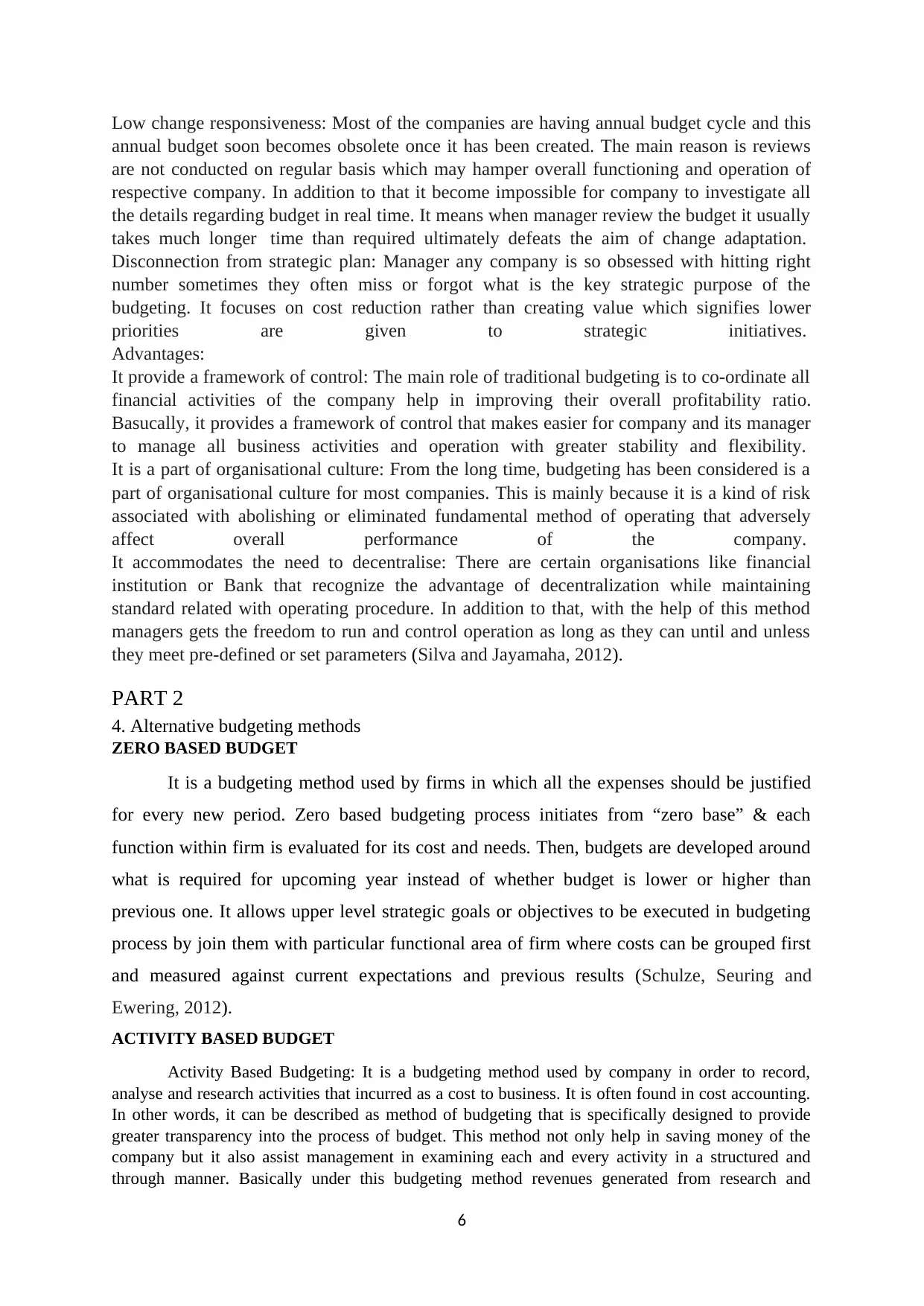
Low change responsiveness: Most of the companies are having annual budget cycle and this
annual budget soon becomes obsolete once it has been created. The main reason is reviews
are not conducted on regular basis which may hamper overall functioning and operation of
respective company. In addition to that it become impossible for company to investigate all
the details regarding budget in real time. It means when manager review the budget it usually
takes much longer time than required ultimately defeats the aim of change adaptation.
Disconnection from strategic plan: Manager any company is so obsessed with hitting right
number sometimes they often miss or forgot what is the key strategic purpose of the
budgeting. It focuses on cost reduction rather than creating value which signifies lower
priorities are given to strategic initiatives.
Advantages:
It provide a framework of control: The main role of traditional budgeting is to co-ordinate all
financial activities of the company help in improving their overall profitability ratio.
Basucally, it provides a framework of control that makes easier for company and its manager
to manage all business activities and operation with greater stability and flexibility.
It is a part of organisational culture: From the long time, budgeting has been considered is a
part of organisational culture for most companies. This is mainly because it is a kind of risk
associated with abolishing or eliminated fundamental method of operating that adversely
affect overall performance of the company.
It accommodates the need to decentralise: There are certain organisations like financial
institution or Bank that recognize the advantage of decentralization while maintaining
standard related with operating procedure. In addition to that, with the help of this method
managers gets the freedom to run and control operation as long as they can until and unless
they meet pre-defined or set parameters (Silva and Jayamaha, 2012).
PART 2
4. Alternative budgeting methods
ZERO BASED BUDGET
It is a budgeting method used by firms in which all the expenses should be justified
for every new period. Zero based budgeting process initiates from “zero base” & each
function within firm is evaluated for its cost and needs. Then, budgets are developed around
what is required for upcoming year instead of whether budget is lower or higher than
previous one. It allows upper level strategic goals or objectives to be executed in budgeting
process by join them with particular functional area of firm where costs can be grouped first
and measured against current expectations and previous results (Schulze, Seuring and
Ewering, 2012).
ACTIVITY BASED BUDGET
Activity Based Budgeting: It is a budgeting method used by company in order to record,
analyse and research activities that incurred as a cost to business. It is often found in cost accounting.
In other words, it can be described as method of budgeting that is specifically designed to provide
greater transparency into the process of budget. This method not only help in saving money of the
company but it also assist management in examining each and every activity in a structured and
through manner. Basically under this budgeting method revenues generated from research and
6
annual budget soon becomes obsolete once it has been created. The main reason is reviews
are not conducted on regular basis which may hamper overall functioning and operation of
respective company. In addition to that it become impossible for company to investigate all
the details regarding budget in real time. It means when manager review the budget it usually
takes much longer time than required ultimately defeats the aim of change adaptation.
Disconnection from strategic plan: Manager any company is so obsessed with hitting right
number sometimes they often miss or forgot what is the key strategic purpose of the
budgeting. It focuses on cost reduction rather than creating value which signifies lower
priorities are given to strategic initiatives.
Advantages:
It provide a framework of control: The main role of traditional budgeting is to co-ordinate all
financial activities of the company help in improving their overall profitability ratio.
Basucally, it provides a framework of control that makes easier for company and its manager
to manage all business activities and operation with greater stability and flexibility.
It is a part of organisational culture: From the long time, budgeting has been considered is a
part of organisational culture for most companies. This is mainly because it is a kind of risk
associated with abolishing or eliminated fundamental method of operating that adversely
affect overall performance of the company.
It accommodates the need to decentralise: There are certain organisations like financial
institution or Bank that recognize the advantage of decentralization while maintaining
standard related with operating procedure. In addition to that, with the help of this method
managers gets the freedom to run and control operation as long as they can until and unless
they meet pre-defined or set parameters (Silva and Jayamaha, 2012).
PART 2
4. Alternative budgeting methods
ZERO BASED BUDGET
It is a budgeting method used by firms in which all the expenses should be justified
for every new period. Zero based budgeting process initiates from “zero base” & each
function within firm is evaluated for its cost and needs. Then, budgets are developed around
what is required for upcoming year instead of whether budget is lower or higher than
previous one. It allows upper level strategic goals or objectives to be executed in budgeting
process by join them with particular functional area of firm where costs can be grouped first
and measured against current expectations and previous results (Schulze, Seuring and
Ewering, 2012).
ACTIVITY BASED BUDGET
Activity Based Budgeting: It is a budgeting method used by company in order to record,
analyse and research activities that incurred as a cost to business. It is often found in cost accounting.
In other words, it can be described as method of budgeting that is specifically designed to provide
greater transparency into the process of budget. This method not only help in saving money of the
company but it also assist management in examining each and every activity in a structured and
through manner. Basically under this budgeting method revenues generated from research and
6
⊘ This is a preview!⊘
Do you want full access?
Subscribe today to unlock all pages.

Trusted by 1+ million students worldwide
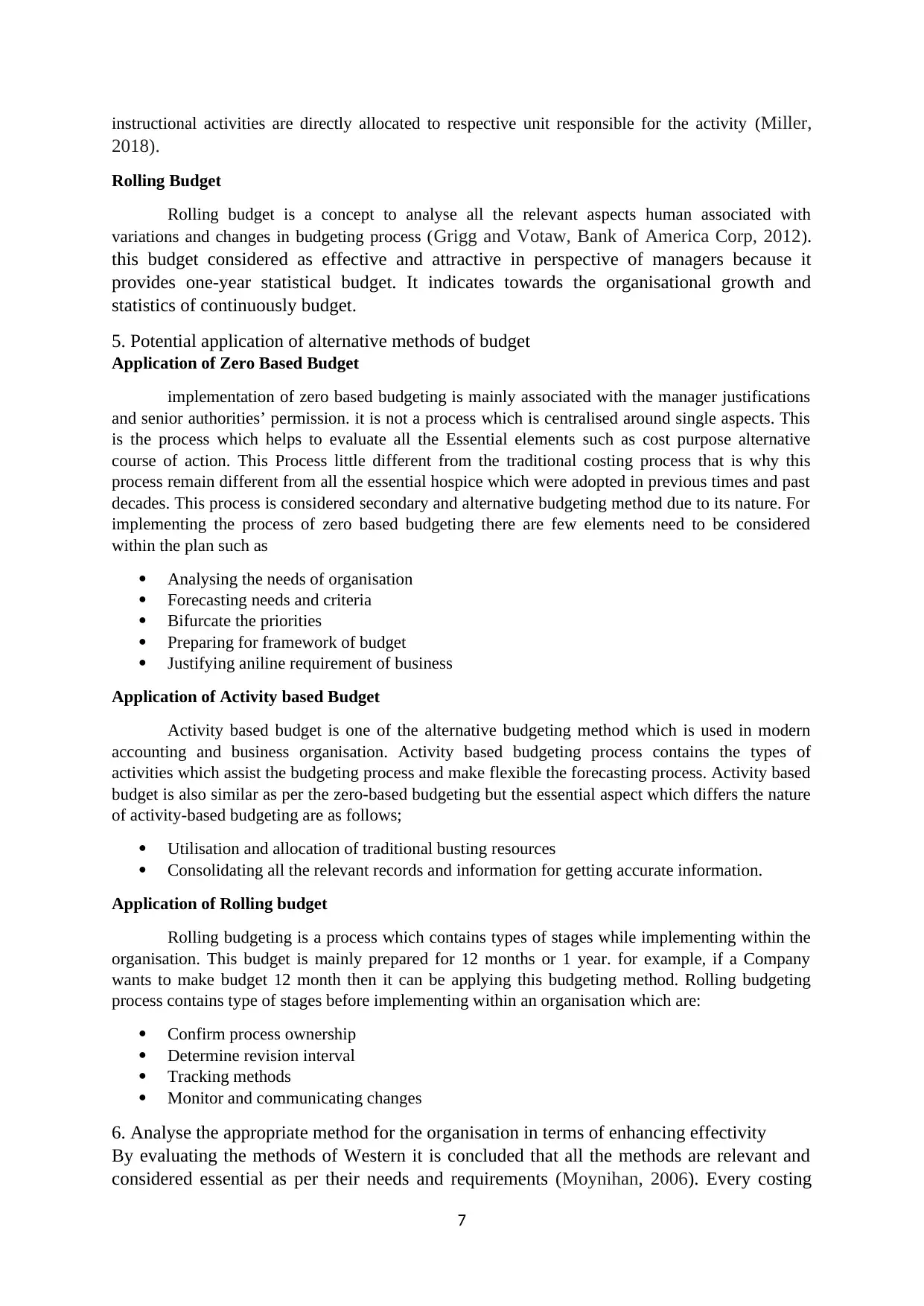
instructional activities are directly allocated to respective unit responsible for the activity (Miller,
2018).
Rolling Budget
Rolling budget is a concept to analyse all the relevant aspects human associated with
variations and changes in budgeting process (Grigg and Votaw, Bank of America Corp, 2012).
this budget considered as effective and attractive in perspective of managers because it
provides one-year statistical budget. It indicates towards the organisational growth and
statistics of continuously budget.
5. Potential application of alternative methods of budget
Application of Zero Based Budget
implementation of zero based budgeting is mainly associated with the manager justifications
and senior authorities’ permission. it is not a process which is centralised around single aspects. This
is the process which helps to evaluate all the Essential elements such as cost purpose alternative
course of action. This Process little different from the traditional costing process that is why this
process remain different from all the essential hospice which were adopted in previous times and past
decades. This process is considered secondary and alternative budgeting method due to its nature. For
implementing the process of zero based budgeting there are few elements need to be considered
within the plan such as
Analysing the needs of organisation
Forecasting needs and criteria
Bifurcate the priorities
Preparing for framework of budget
Justifying aniline requirement of business
Application of Activity based Budget
Activity based budget is one of the alternative budgeting method which is used in modern
accounting and business organisation. Activity based budgeting process contains the types of
activities which assist the budgeting process and make flexible the forecasting process. Activity based
budget is also similar as per the zero-based budgeting but the essential aspect which differs the nature
of activity-based budgeting are as follows;
Utilisation and allocation of traditional busting resources
Consolidating all the relevant records and information for getting accurate information.
Application of Rolling budget
Rolling budgeting is a process which contains types of stages while implementing within the
organisation. This budget is mainly prepared for 12 months or 1 year. for example, if a Company
wants to make budget 12 month then it can be applying this budgeting method. Rolling budgeting
process contains type of stages before implementing within an organisation which are:
Confirm process ownership
Determine revision interval
Tracking methods
Monitor and communicating changes
6. Analyse the appropriate method for the organisation in terms of enhancing effectivity
By evaluating the methods of Western it is concluded that all the methods are relevant and
considered essential as per their needs and requirements (Moynihan, 2006). Every costing
7
2018).
Rolling Budget
Rolling budget is a concept to analyse all the relevant aspects human associated with
variations and changes in budgeting process (Grigg and Votaw, Bank of America Corp, 2012).
this budget considered as effective and attractive in perspective of managers because it
provides one-year statistical budget. It indicates towards the organisational growth and
statistics of continuously budget.
5. Potential application of alternative methods of budget
Application of Zero Based Budget
implementation of zero based budgeting is mainly associated with the manager justifications
and senior authorities’ permission. it is not a process which is centralised around single aspects. This
is the process which helps to evaluate all the Essential elements such as cost purpose alternative
course of action. This Process little different from the traditional costing process that is why this
process remain different from all the essential hospice which were adopted in previous times and past
decades. This process is considered secondary and alternative budgeting method due to its nature. For
implementing the process of zero based budgeting there are few elements need to be considered
within the plan such as
Analysing the needs of organisation
Forecasting needs and criteria
Bifurcate the priorities
Preparing for framework of budget
Justifying aniline requirement of business
Application of Activity based Budget
Activity based budget is one of the alternative budgeting method which is used in modern
accounting and business organisation. Activity based budgeting process contains the types of
activities which assist the budgeting process and make flexible the forecasting process. Activity based
budget is also similar as per the zero-based budgeting but the essential aspect which differs the nature
of activity-based budgeting are as follows;
Utilisation and allocation of traditional busting resources
Consolidating all the relevant records and information for getting accurate information.
Application of Rolling budget
Rolling budgeting is a process which contains types of stages while implementing within the
organisation. This budget is mainly prepared for 12 months or 1 year. for example, if a Company
wants to make budget 12 month then it can be applying this budgeting method. Rolling budgeting
process contains type of stages before implementing within an organisation which are:
Confirm process ownership
Determine revision interval
Tracking methods
Monitor and communicating changes
6. Analyse the appropriate method for the organisation in terms of enhancing effectivity
By evaluating the methods of Western it is concluded that all the methods are relevant and
considered essential as per their needs and requirements (Moynihan, 2006). Every costing
7
Paraphrase This Document
Need a fresh take? Get an instant paraphrase of this document with our AI Paraphraser
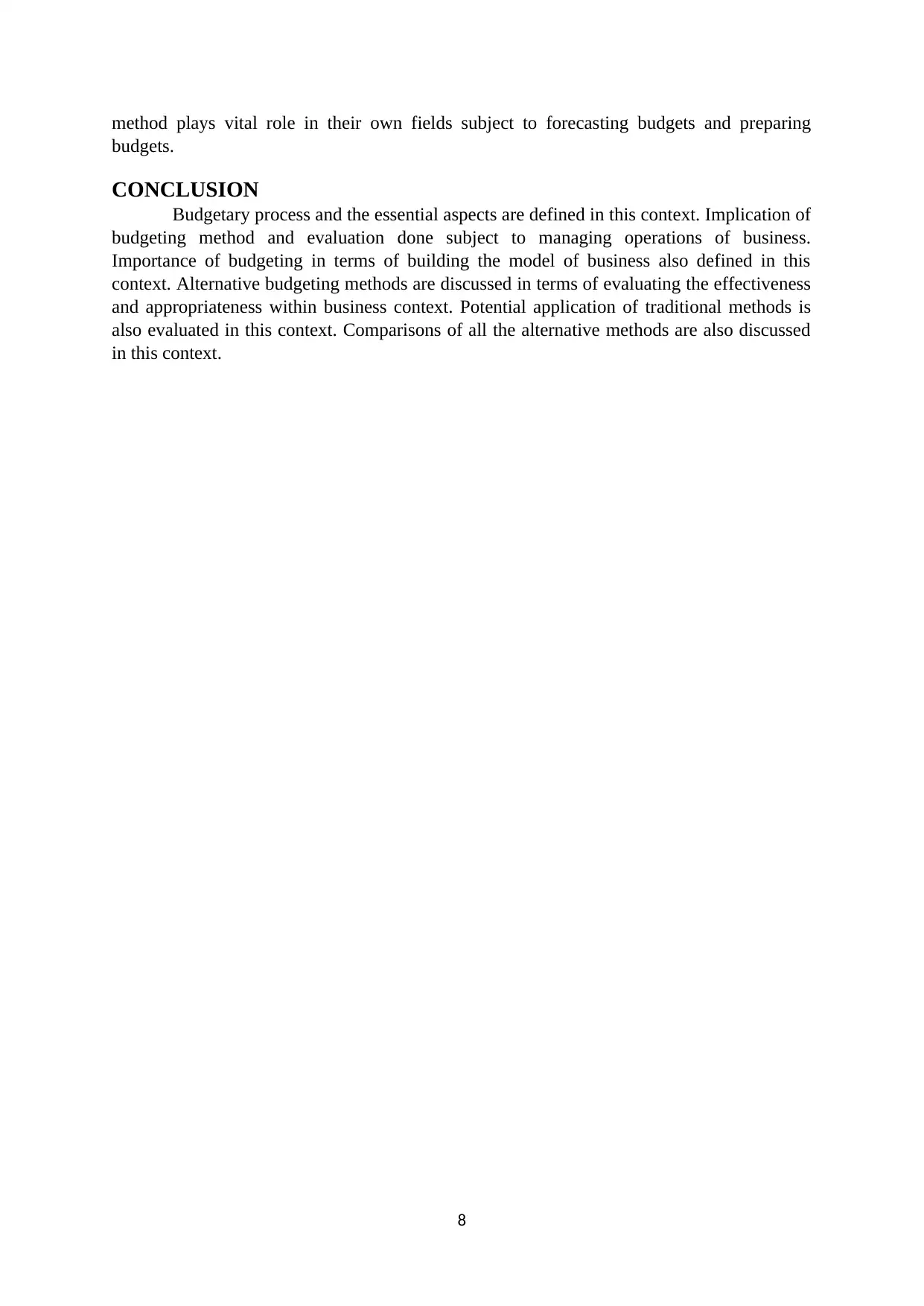
method plays vital role in their own fields subject to forecasting budgets and preparing
budgets.
CONCLUSION
Budgetary process and the essential aspects are defined in this context. Implication of
budgeting method and evaluation done subject to managing operations of business.
Importance of budgeting in terms of building the model of business also defined in this
context. Alternative budgeting methods are discussed in terms of evaluating the effectiveness
and appropriateness within business context. Potential application of traditional methods is
also evaluated in this context. Comparisons of all the alternative methods are also discussed
in this context.
8
budgets.
CONCLUSION
Budgetary process and the essential aspects are defined in this context. Implication of
budgeting method and evaluation done subject to managing operations of business.
Importance of budgeting in terms of building the model of business also defined in this
context. Alternative budgeting methods are discussed in terms of evaluating the effectiveness
and appropriateness within business context. Potential application of traditional methods is
also evaluated in this context. Comparisons of all the alternative methods are also discussed
in this context.
8
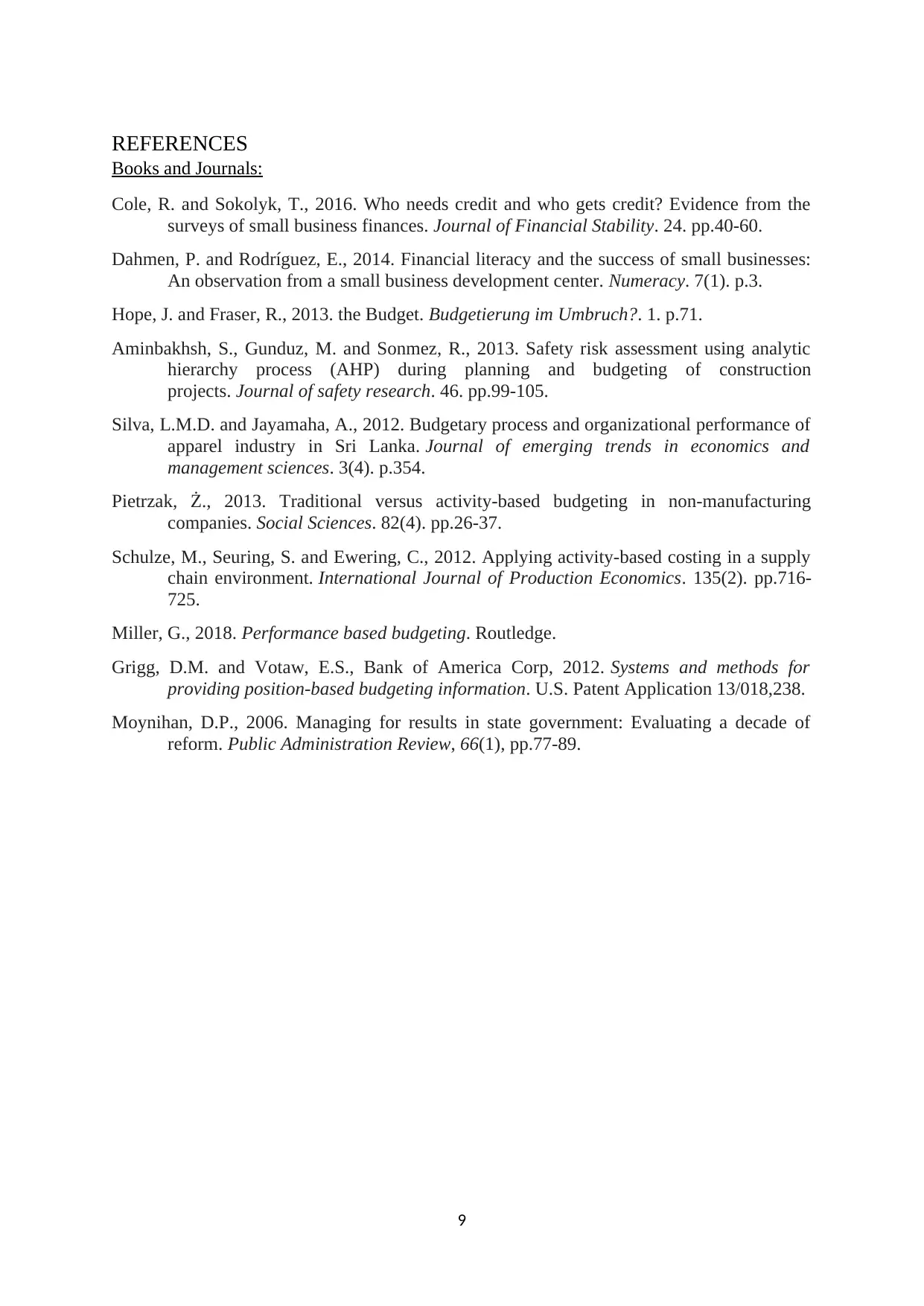
REFERENCES
Books and Journals:
Cole, R. and Sokolyk, T., 2016. Who needs credit and who gets credit? Evidence from the
surveys of small business finances. Journal of Financial Stability. 24. pp.40-60.
Dahmen, P. and Rodríguez, E., 2014. Financial literacy and the success of small businesses:
An observation from a small business development center. Numeracy. 7(1). p.3.
Hope, J. and Fraser, R., 2013. the Budget. Budgetierung im Umbruch?. 1. p.71.
Aminbakhsh, S., Gunduz, M. and Sonmez, R., 2013. Safety risk assessment using analytic
hierarchy process (AHP) during planning and budgeting of construction
projects. Journal of safety research. 46. pp.99-105.
Silva, L.M.D. and Jayamaha, A., 2012. Budgetary process and organizational performance of
apparel industry in Sri Lanka. Journal of emerging trends in economics and
management sciences. 3(4). p.354.
Pietrzak, Ż., 2013. Traditional versus activity-based budgeting in non-manufacturing
companies. Social Sciences. 82(4). pp.26-37.
Schulze, M., Seuring, S. and Ewering, C., 2012. Applying activity-based costing in a supply
chain environment. International Journal of Production Economics. 135(2). pp.716-
725.
Miller, G., 2018. Performance based budgeting. Routledge.
Grigg, D.M. and Votaw, E.S., Bank of America Corp, 2012. Systems and methods for
providing position-based budgeting information. U.S. Patent Application 13/018,238.
Moynihan, D.P., 2006. Managing for results in state government: Evaluating a decade of
reform. Public Administration Review, 66(1), pp.77-89.
9
Books and Journals:
Cole, R. and Sokolyk, T., 2016. Who needs credit and who gets credit? Evidence from the
surveys of small business finances. Journal of Financial Stability. 24. pp.40-60.
Dahmen, P. and Rodríguez, E., 2014. Financial literacy and the success of small businesses:
An observation from a small business development center. Numeracy. 7(1). p.3.
Hope, J. and Fraser, R., 2013. the Budget. Budgetierung im Umbruch?. 1. p.71.
Aminbakhsh, S., Gunduz, M. and Sonmez, R., 2013. Safety risk assessment using analytic
hierarchy process (AHP) during planning and budgeting of construction
projects. Journal of safety research. 46. pp.99-105.
Silva, L.M.D. and Jayamaha, A., 2012. Budgetary process and organizational performance of
apparel industry in Sri Lanka. Journal of emerging trends in economics and
management sciences. 3(4). p.354.
Pietrzak, Ż., 2013. Traditional versus activity-based budgeting in non-manufacturing
companies. Social Sciences. 82(4). pp.26-37.
Schulze, M., Seuring, S. and Ewering, C., 2012. Applying activity-based costing in a supply
chain environment. International Journal of Production Economics. 135(2). pp.716-
725.
Miller, G., 2018. Performance based budgeting. Routledge.
Grigg, D.M. and Votaw, E.S., Bank of America Corp, 2012. Systems and methods for
providing position-based budgeting information. U.S. Patent Application 13/018,238.
Moynihan, D.P., 2006. Managing for results in state government: Evaluating a decade of
reform. Public Administration Review, 66(1), pp.77-89.
9
⊘ This is a preview!⊘
Do you want full access?
Subscribe today to unlock all pages.

Trusted by 1+ million students worldwide
1 out of 9
Related Documents
Your All-in-One AI-Powered Toolkit for Academic Success.
+13062052269
info@desklib.com
Available 24*7 on WhatsApp / Email
![[object Object]](/_next/static/media/star-bottom.7253800d.svg)
Unlock your academic potential
Copyright © 2020–2025 A2Z Services. All Rights Reserved. Developed and managed by ZUCOL.





